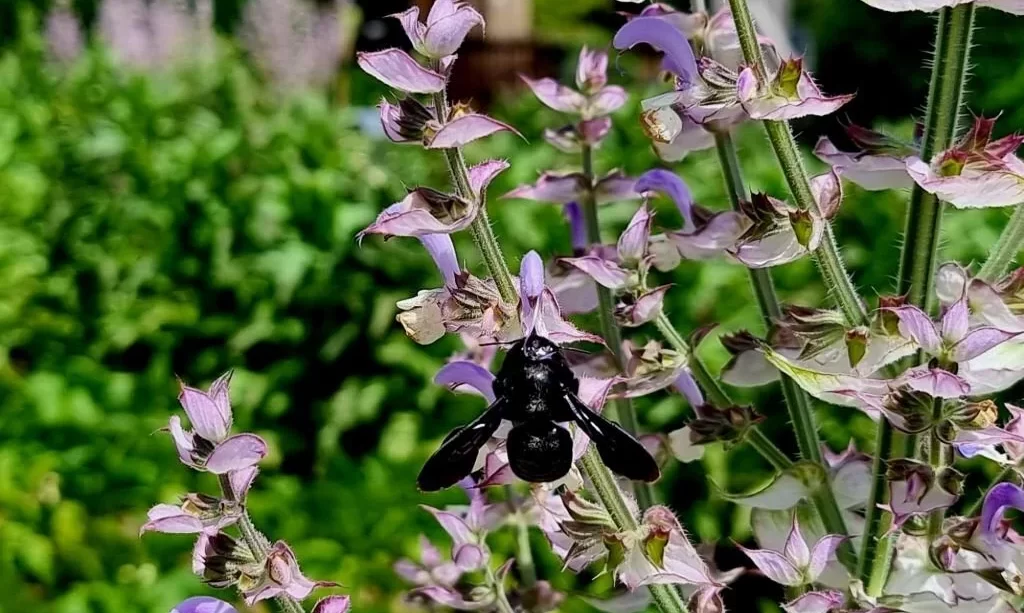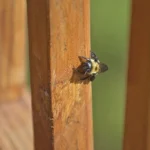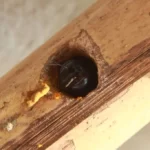Carpenter bees, often seen hovering around gardens and wooden structures, are fascinating pollinators with unique nesting habits. While they play a crucial role in pollinating flowers, understanding their behavior and preferences is essential for homeowners and garden enthusiasts. By gaining insights into what attracts carpenter bees, we can protect our property while fostering a more bee-friendly environment. In this guide, we will delve into the world of carpenter bees, starting with an exploration of their behavior and nesting habits. This knowledge will help us appreciate these valuable pollinators while taking steps to mitigate potential damage to our wooden structures.
- TERMITE KILLER: Kills the termites you see, and the ones you don’t see
- INSECT KILLER: Plus kills other wood-infesting insects including Carpenter Bees, Ants, Beetles, and more
- FOAM SPRAY: The foam expands at a 30:1 ratio to fill cracks
- EASY APPLICATION: Do it like the pros do- get the hard-to-reach areas with ease
Carpenter Bee Behavior
Carpenter bees are solitary insects, setting them apart from their more social cousins, honey bees. This solitary nature extends to their nesting habits, making them fascinating creatures to study. Here are some key aspects of carpenter bee behavior:
- Solitary Nesting: Unlike honey bees that live in colonies, carpenter bees prefer a solitary lifestyle. Each female carpenter bee establishes her own nest, typically within wooden structures.
- Wood-Boring Habit: Carpenter bees are known for their unique nesting behavior. They create cylindrical holes in wood, often mistaken for termite damage. These holes serve as tunnels leading to nesting chambers.
- Nesting Site Selection: Carpenter bees are selective when it comes to choosing a nesting site. They prefer softwoods like cedar, pine, and redwood. Unpainted and weathered wood is more appealing to them than fresh, smooth, or painted surfaces.
- Pollinators: Despite their nesting habits, carpenter bees are important pollinators. As they visit flowers in search of nectar, they transfer pollen from one bloom to another, aiding in the reproduction of various plant species.
Understanding carpenter bee behavior is the foundation for learning what attracts them to certain areas and how we can strike a balance between protecting our property and supporting their vital role in our ecosystem.
Wood Preferences
Carpenter bees are discerning when it comes to their choice of nesting sites, and their wood preferences play a significant role in what attracts them. Here are some key aspects of their wood preferences:
- Softwoods: Carpenter bees favor softwoods, such as cedar, pine, and redwood, for nesting. These woods are easier for them to bore into and create their tunnels and chambers.
- Weathered Wood: Unpainted and weathered wood is particularly appealing to carpenter bees. The aging process can make the wood softer and more accommodating for their nesting activities.
- Fresh, Smooth Wood: In contrast, fresh, smooth, or painted wood is less attractive to carpenter bees. The harder surface and lack of weathering make it more challenging for them to begin their nesting process.
Understanding these wood preferences can help homeowners make informed decisions about the types of wood used in outdoor structures and how to maintain them to deter carpenter bees.
Sunlight and Warmth
Carpenter bees are also drawn to specific environmental conditions, including sunlight and warmth. Here’s how these factors contribute to what attracts carpenter bees:
- Direct Sunlight: Carpenter bees are more likely to select nesting sites that receive ample direct sunlight. Sunlight helps regulate the temperature within their nests, creating a more suitable environment for their larvae.
- Southern and Western Exposure: Areas with southern or western exposure tend to attract carpenter bees because they receive the most sunlight during the day. These locations offer optimal conditions for their nesting sites.
Understanding the preference for sunlight and warmth helps homeowners identify potential nesting areas and consider ways to modify these conditions to deter carpenter bees.
Floral Attraction
While carpenter bees are known for their wood-boring habits, they are also vital pollinators attracted to flowering plants. Here’s how floral attraction contributes to what attracts carpenter bees:
- Nectar-Rich Flowers: Carpenter bees seek out nectar-rich flowers for their food source. They are especially drawn to plants that provide ample nectar, such as salvia, lavender, and sunflowers.
- Pollination Role: As they visit these flowers in search of nectar, carpenter bees inadvertently transfer pollen from one bloom to another. This pollination activity aids in the reproduction of various plant species.
By understanding the role of floral attraction, homeowners can create a more bee-friendly garden by planting a variety of nectar-rich flowers while simultaneously reducing the appeal of wooden structures for nesting.
- Eliminate Wasps – Our exclusive VisiLure technology lures wasps, red wasps, mud daubers, and carpenter bees with appealing colors and a multi-dimensional pattern. Once attracted, they become stuck to the sticky surface and expire.
- Visual Attractant – The targeted insects are naturally lured to the trap without odors, chemicals, or wasp sprays. It catches queens and workers, from spring through fall.
- Thoughtful Design – Our unique Glue Guards create a barrier around the sticky trap surface to reduce the chances of non-insect catches.
- Prevent Damage – Mud daubers (mud wasps, dirt daubers) and carpenter bees can cause serious property damage. Our TrapStik can stop this before it starts, without the use of potentially harmful sprays or chemicals.
- Made in the USA – At RESCUE!, our goal is to design, manufacture, and market the safest and most effective pest control solutions available for homeowners. We are proud to manufacture our products in the USA!
Drilling Sounds and Vibration
Carpenter bees employ unique methods to communicate and attract mates. Here’s how drilling sounds and vibrations contribute to what attracts carpenter bees:
- Mating Rituals: Male carpenter bees engage in elaborate courtship displays to attract females. They create loud drilling sounds by rapidly vibrating their wings while in flight. This audible display, coupled with their aerial acrobatics, is meant to impress potential mates.
- Signaling Nesting Sites: Male carpenter bees may also use vibrations to signal potential nesting sites to females. By emitting vibrations near a suitable wooden structure, they indicate a potential location for a nest.
Understanding these behaviors can help homeowners differentiate between the mesmerizing courtship displays of male carpenter bees and the potential threats posed by their drilling activities.
Avoiding Attraction and Mitigating Damage
Given their importance as pollinators, it’s essential to coexist with carpenter bees while protecting your property. Here are some strategies for avoiding attraction and mitigating potential damage:
- Seal and Paint Wood: Regularly inspect and maintain wooden structures by sealing cracks and applying paint or sealant. Fresh, painted wood is less appealing to carpenter bees.
- Use Hardwoods: When building outdoor structures, consider using hardwoods that are less susceptible to carpenter bee nesting. Hardwoods are denser and more challenging for them to bore into.
- Plant Bee-Friendly Gardens: Encourage carpenter bees to forage away from wooden structures by planting nectar-rich flowers in your garden. This can divert their attention from potential nesting sites.
- Deterrents: Use deterrents like loud noises, vibrations, or scents near susceptible areas to discourage carpenter bees from nesting there.
- Professional Assistance: If carpenter bee infestations become problematic, consider seeking professional pest control assistance to safely relocate nests and protect your property.
- CARPENTER BEE LURE
- CARPENTER BEE ATRACTANT
- WORKS WITH CARPENTER BEES
- ATTRACTS CARPENTER BEES NATURALLY
Conclusion
Understanding what attracts carpenter bees is crucial for striking a balance between preserving these valuable pollinators and safeguarding your property. While their nesting habits can lead to structural damage, homeowners can take proactive measures to mitigate attraction and potential harm. By maintaining and protecting wooden structures, planting bee-friendly gardens, and using deterrents when necessary, we can coexist with carpenter bees and appreciate their essential role in our ecosystem. This harmonious approach allows us to protect our homes and support the vital work of these remarkable pollinators.







